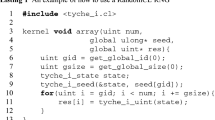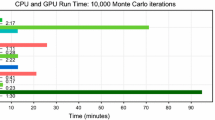Abstract
Pseudorandom number generators are required for many computational tasks, such as stochastic modelling and simulation. This paper investigates the serial and parallel implementation of a Linear Congruential Generator for Graphics Processing Units (GPU) based on the binary representation of the normal number \(\alpha _{2,3}\). We adapted two methods of modular reduction which allowed us to perform most operations in 64-bit integer arithmetic, improving on the original implementation based on 106-bit double-double operations, which resulted in four-fold increase in efficiency. We found that our implementation is faster than existing methods in literature, and our generation rate is close to the limiting rate imposed by the efficiency of writing to a GPU’s global memory.






Similar content being viewed by others
References
Agner F (2004–2012) Optimizing software in C++: an optimization guide for Windows, Linux and Mac platforms. Copenhagen University College of Engineering, Copenhagen. http://www.agner.org/optimize/optimizing_cpp.pdf
Atkinson AC, Pearce MC (1976) The computer generation of beta, gamma and normal random variables. J R Stat Soc Ser A (General) 139:431–461
Bailey D (2012) High-precision software directory. http://crd-legacy.lbl.gov/~dhbailey/mpdist/, accessed 1 September, 2012
Bailey D, Borwein J (2011) Normal numbers and pseudorandom generators. In: Proceedings of the workshop on computational and analytical mathematics in honour of Jonathan Borwein’s 60th birthday. Springer, New York. http://crd.lbl.gov/~dhbailey/dhbpapers/normal-pseudo.pdf
Bailey D, Crandall R (2000) Random generators and normal numbers. Exp Math 11:527–546
Barrett P (1987) Implementing the Rivest Shamir and Adleman public key encryption algorithm on a standard digital signal processor. In: Proceedings on advances in cryptology—CRYPTO ’86, pp 311–323. Springer, London
Beliakov G (2005) Class library ranlip for multivariate nonuniform random variate generation. Comput Phys Commun 170:93–108
Blum M (1982) How to generate cryptographically strong sequences of pseudo random bits. In: 23rd annual symposium on foundations of computer science, pp 112–117
Bratley P, Bennet F, Schrage L (1987) A Guide to Simulation, 2nd edn. Springer, Berlin
Gladkov D, Tapia J, Alberts S, D’Souza R (2012) Graphics processing unit based direct simulation Monte Carlo. Simulation 88:680–693
Hörmann W, Leydold J, Derflinger G (2004) Automatic nonuniform random variate generation. Springer, Berlin
Howes L, Thomas D (2007) Efficient random number generation and application using CUDA, chap. 37. In: Hubert N (ed) GPU Gems 3. Addison Wesley, New York
L’Ecuyer P (1988) Efficient and portable combined random number generators. Commun ACM 31:742–751
L’Ecuyer P (1994) Uniform random number generation. Ann Oper Res 53:77–120
L’Ecuyer P, Cordeau J, Simard R (2000) Close-point spatial tests and their application to random number generators. Oper Res 48:308–317
L’Ecuyer P, Simard R (2007) Testu01: a C library for empirical testing of random number generators. ACM Trans Math Softw 33 (article 22)
L’Ecuyer P, Simard R, Chen J, Kelton D (2002) An object-oriented random-number package with many long streams and substreams. Oper Res 50:1073–1075
Menezes AJ, van Oorschot PC, Vanstone SA (eds) (1996) Handbook of applied cryptography. CRC Press, Boca Raton
NVIDIA (2012) CUDA Zone. http://www.nvidia.com/object/cuda_home.html (last accessed 1 June, 2012)
NVIDIA (2012) CUDA Zone SDK Samples. http://developer.nvidia.com/cuda-cc-sdk-code-samples (last accessed 1 June, 2012)
NVIDIA (2012) Double-double precision arithmetic. http://developer.nvidia.com/rdp/assets/double-double-precision-arithmetic (last accessed 4 June, 2012)
NVIDIA (2012) NVIDIA CUDA Programming Guide, http://http://developer.nvidia.com/nvidia-gpu-computing-documentation (last accessed 1 June, 2012)
Passerat-Palmbach J, Mazel C, Hill D (2011) Pseudo-random number generation on GP-GPU. In: 2011 IEEE workshop on principles of advanced and distributed simulation. IEEE Computer Society, Los Alamitos, pp 1–8
Saito M, Matsumoto M (2010) Variants of Mersenne twister suitable for graphic processors. ArXiv e-prints 1005.4973. http://arxiv.org/abs/1005.4973
Author information
Authors and Affiliations
Corresponding author
Rights and permissions
About this article
Cite this article
Beliakov, G., Johnstone, M., Creighton, D. et al. An efficient implementation of Bailey and Borwein’s algorithm for parallel random number generation on graphics processing units. Computing 95, 309–326 (2013). https://doi.org/10.1007/s00607-012-0234-8
Received:
Accepted:
Published:
Issue Date:
DOI: https://doi.org/10.1007/s00607-012-0234-8




